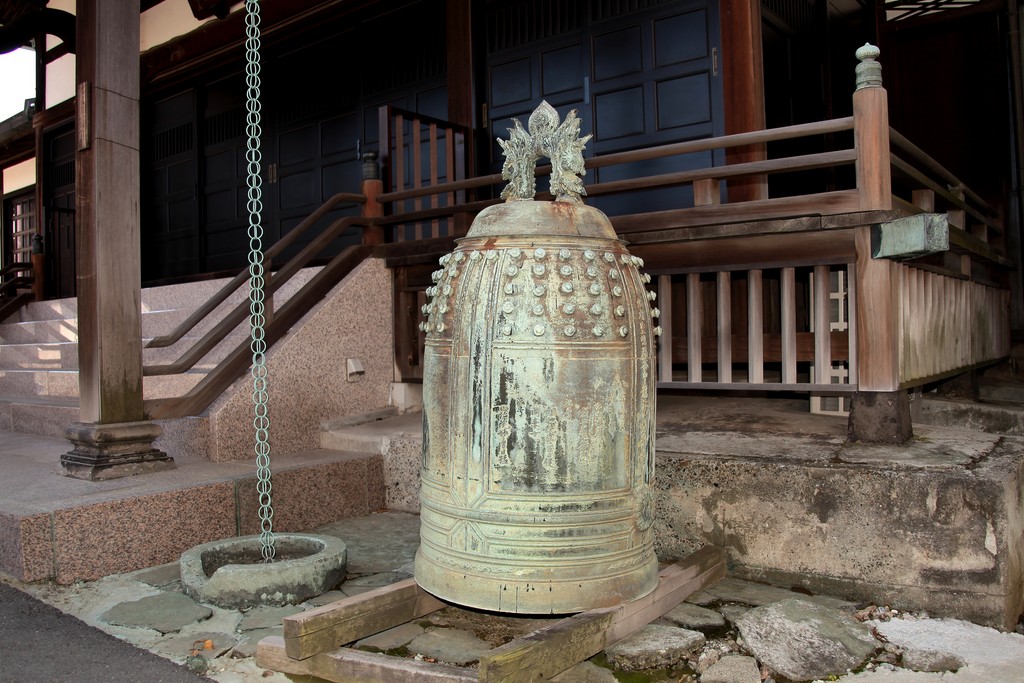BRONZE BELL DAIENJI TEMPLE
Les bonshō (梵鐘, cloches bouddhiques), aussi connues sous le nom de tsurigane (釣り鐘, cloches suspendues) ou ōgane (大鐘, grandes cloches) sont des cloches dans les temples bouddhistes au Japon utilisées pour appeler les moines à la prière et à marquer le temps.
Les cloches sont généralement faites en bronze, selon un procédé de coulée à moule perdu. Elles sont décorées de bossages, de bandes et d'inscriptions. Ne contenant pas de battant, les bonshō sont frappés à l'aide de maillet ou de poutre suspendue à des cordes. La tonalité pénétrante et envahissante des cloches porte sur des distances considérables, ce qui a conduit à leur utilisation pour marquer le temps et comme signal ou alarme.
Au Japon, la première de ces cloches date de 600 avant J.-C., même si la conception générale a une origine chinoise plus ancienne et partage des caractéristiques observées sur des cloches chinoises. Tout au long de l'histoire du Japon, les cloches ont été associées à des contes et légendes, comme la cloche Benkei de Mii-dera, ou celle plus historique de Hōkō-ji.
La signification spirituelle de bonshō leur fait jouer un rôle important dans les cérémonies bouddhistes, en particulier lors du Nouvel An japonais ou du matsuri O-Bon. À l'époque moderne, le son du bonshō est devenu symbole de Paix dans le monde.
--------------------------------------------
Bonshō 梵鐘 (Buddhist bells), also known as tsurigane 釣り鐘 (hanging bells) or ōgane 大鐘 (great bells) are large bells from Japan. They are found in Buddhist temples throughout the country, where they are used to summon the monks to prayer and to demarcate periods of time. Rather than containing a clapper, bonshō are struck from the outside, using either a hand-held mallet or a beam suspended on ropes. The bells are usually made from bronze, using a form of expendable mold casting. They have similarities to ancient Chinese bell designs, and are thought to be of Chinese origin. Their penetrating and pervasive tone carries over considerable distance, and is thought to have supernatural properties such as being heard in the underworld; their spiritual significance means that Bonshō play an important role in Buddhist ceremonies, particularly the New Year and Obon festivals. Throughout Japanese history a number of these bells become associated with stories and legends, such as the Benkei Bell of Mii-dera.
Origin
Bronze bells have been found in numerous archeological sites in Japan, most commonly in Shiga Prefecture. The similarity of designs on these bells to those of Yamato period pottery suggests that they are relics of that culture, which would mean that they date to the sixth century or earlier. Similar bells from China date back as far as the Zhou Dynasty (1046–256 BC), where they were used for military signalling. The bonshō is believed to have been derived from the bianzhong (henshō 編鐘 in Japanese), an ancient Chinese court instrument comprising a series of tuned bells. One larger, additional bell was used both as a tuning device and as a summons to listeners to attend the performance; this bell would eventually develop into the bonshō.
--------------------------------------------
Bonshō 梵鐘 (Buddhist bells), also known as tsurigane 釣り鐘 (hanging bells) or ōgane 大鐘 (great bells) are large bells from Japan. They are found in Buddhist temples throughout the country, where they are used to summon the monks to prayer and to demarcate periods of time. Rather than containing a clapper, bonshō are struck from the outside, using either a hand-held mallet or a beam suspended on ropes. The bells are usually made from bronze, using a form of expendable mold casting. They have similarities to ancient Chinese bell designs, and are thought to be of Chinese origin. Their penetrating and pervasive tone carries over considerable distance, and is thought to have supernatural properties such as being heard in the underworld; their spiritual significance means that Bonshō play an important role in Buddhist ceremonies, particularly the New Year and Obon festivals. Throughout Japanese history a number of these bells become associated with stories and legends, such as the Benkei Bell of Mii-dera.
Origin
Bronze bells have been found in numerous archeological sites in Japan, most commonly in Shiga Prefecture. The similarity of designs on these bells to those of Yamato period pottery suggests that they are relics of that culture, which would mean that they date to the sixth century or earlier. Similar bells from China date back as far as the Zhou Dynasty (1046–256 BC), where they were used for military signalling. The bonshō is believed to have been derived from the bianzhong (henshō 編鐘 in Japanese), an ancient Chinese court instrument comprising a series of tuned bells. One larger, additional bell was used both as a tuning device and as a summons to listeners to attend the performance; this bell would eventually develop into the bonshō.
